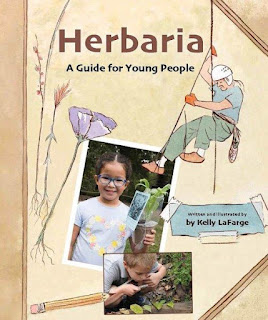Last spring was a tough time for new book releases, what with libraries, schools, and book stores unable to host public events. So this spring I’m sharing some STEAM books that I didn’t get time to review, and I feel are worth another look. And since spring is here and plants are beginning to grow, I thought today would be perfect for looking at…
Herbaria: A Guide for Young People
by Kelly LaFarge
34 pages; ages 8-12
Missouri Botanical Garden Press, 2021
The first thing I noticed about this book is that it’s almost as big as my plant press!
The second thing I noticed was the question on the back cover: What good is a dead plant? It’s a good question, for sure.
Live plants give us oxygen. They capture carbon. They provide fruits and leafy greens for us to eat, and food for animals. They clean pollutants from the air, provide shade, moderate temperature, and beautify the world.
Dead plants, says Kelly LaFarge, “can be as useful to us as living ones.” Especially when they are collected in plant museums, called Herbaria. Just as scientists use museum collections to study birds and mammals and insects, they use herbarium collections to study plants. Medical researchers can use samples of plants to aid in their inventions of new medicines. Farmers can learn about weeds, and ecologists can study plant diversity and their geographical range.
Remember the Lewis and Clark expedition? Back in 1803 President Thomas Jefferson directed them to bring back information about the plants and animals found west of the Mississippi. They observed, recorded, drew pictures of, and collected plants from the west – information that helped leaders understand more about the new world. Those samples are preserved in an herbarium, available for researchers interested in learning how the plant populations have changed in the past 200-plus years.
In addition to introducing the why of Herbaria, LaFarge shows how plants are collected and preserved. Her text illustrations are augmented with lift-up flaps (what’s inside a plant press?), field notebook pages, envelopes, and other interactive things to explore. There’s a glossary and a list of herbaria to visit, should you be so inclined. There’s even a side bar about a kid who discovered a new species in his backyard.
This weekend, pay attention to the plants growing around you. On Monday, come back to find out how to make a simple plant press so you can create an herbarium of your own.
Thanks for dropping by today. On Monday we'll be hanging out at Marvelous Middle Grade Monday with other bloggers. It's over at Greg Pattridge's blog, Always in the Middle, so hop over to see what other people are reading. Review copy provided by the author.


Thanks for telling me about this book. I will try to check it out.
ReplyDeleteThanks or sharing about this book this week. It sounds like a great one to learn lots more about plants.
ReplyDeleteI learned something new. Never heard the word Herbaria before. Fascinating review about plants and what dead plants can tell/show us. Thanks for sharing today!
ReplyDeleteThis looks like an interesting book. Thanks for introducing us to it.
ReplyDeleteI used to have a neighbor named Herb Aria. Not sure where he lives now but he'd certainly be surprised. I always enjoy any books about plants or nature. Thanks for sharing this unique title on MMGM.
ReplyDeleteNever heard of herbaria either, though is it just a fancy name for plant press? An interesting book, thanks for the review!
ReplyDeleteAn herbarium is a collection of plant specimens. Imagine a pressed plant on a large sheet of paper, with a label. It, and other specimens of that species, are kept in a large file folder which is placed flat on a shelf. Researchers can come in and look at the specimens.
Delete